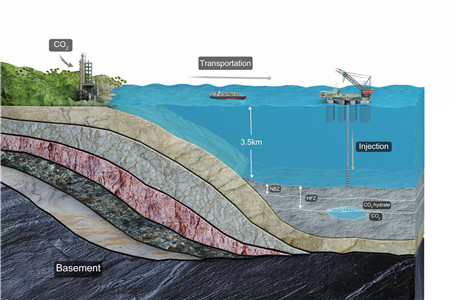Sequestration of CO2 in deep-sea sediments could lead to safe, efficient and permanent storage
Jul 06, 2018
Peking University, July 6, 2018: A recent innovative research investigates the long-term viability of CO2 storage in deep-sea sediments through studying the coupled processes of injection and post-injection fate of CO2. This study provides valuable insights not only into the interaction of the competing processes of buoyant flow, potential hydrate formation and decreasing buoyancy, but also into the feasibility, safety, and permanence of this option under different geological and operational conditions.
The findings are being reported in the journal Science Advances, in a paper by Mr. Teng Yihua and his Ph.D. supervisor Professor Zhang Dongxiao in College of Engineering and Institute of Ocean Research at Peking University (PKU).
Carbon capture and storage (CCS) is considered to be a promising option to stabilize the atmospheric concentration of anthropogenic CO2 and mitigate climate change. Conventional proposals for geologic sequestration, including injection into deep saline aquifers, oil and gas fields, and deep coal seams are prospective, but the stored supercritical CO2 is buoyant and consequently may escape from permeable pathways into the atmosphere.
In contrast, at high pressure and low temperature, the negative buoyancy effect induced by high density of liquid CO2, together with the formation of CO2 hydrate can provide an effective barrier to prevent the upward flow of the injected CO2. Sequestration of CO2 in deep-sea sediments takes advantage of the high pressure and low temperature of subsea sediments. The required infrastructure of this option is similar to that used in the recent pilot of natural gas hydrate extraction in South China Sea.

Schematic illustration of carbon sequestration in deep-sea sediments
While this topic is much related to engineering, Zhang says, the primary interest of the work is to solve the scientific problem of whether sequestering CO2 in the deep-sea sediments is viable in the long term through studying the multi-physics process of injection and post-injection fate of CO2 in the subsea sediments.
“Our goal was to understand how the system evolves under complex interactions between phases and components over time, so that we can effectively evaluate the viability of this option”, Zhang says, “This requires an accurate description of the multi-physics process of CO2 transport in the porous sediment, including multiphase and multicomponent flow, non-isothermal effect due to heat flow, chemical reaction due to potential hydrate formation and dissociation, and dynamics of dissolved components”.
However, coupling all the related physical processes is very difficult in application due to the complexity of the system. “Compared with previous studies, the superiority of our study is the incorporation of the dynamics of dissolved components and their corresponding effects on hydrate reaction and fluid flow,” Teng says. “This allows us to study the long-term evolution of different phases and components, such as density-driven convection, and dissolution of liquid CO2 and hydrate. Consequently, we are able to predict the long-term fate of the injected CO2, which is not possible in previous studies.”
The researchers want to see if the two major mechanisms could effectively prevent the upward migration of the injected CO2. The injected CO2 is still buoyant and the upward flow of it disturbs the pressure and temperature profile. “If the buoyancy-driven upward flow is too fast, the injected CO2 may not be sufficiently cooled down, which means that hydrate may not form even if CO2 plume enter the hydrate formation zone in static condition.” Teng says, “Whether CO2 will escape or be trapped depends on the interaction of the competing processes of buoyant flow, hydrate formation, and density increase of CO2 induced by heat loss.”
Results of the base case show that the low buoyancy and the formation of hydrate effectively trap the injected CO2 in a cage-like system and the injected CO2 will finally dissolve and migrate away through diffusion in the long term. This leads to permanent storage.
“We are very excited about the results, because it proves that this option is long-term viable and certainly would be an alternative of terrestrial sequestration.” Teng says. This work advances the topic of sub-seabed storage of CO2 substantially. As pointed out during the review process, “this paper may, in fact, put carbon sequestration in subsea sediments back on the map of viable storage options.”
After getting these results, a salient question would be: what will happen if the natural settings and operational conditions are different? The authors performed sensitivity studies to investigate the viability of sub-seabed disposal of CO2 under different geological and operational conditions. “It’s very important to examine the impact of different input parameters of the model, since the impedance exerted on CO2 plume may change significantly when the settings are changed, such as the ocean depth.” Says Zhang.
The results of the sensitivity study show that the storage efficiency is very sensitive to ocean depth and vertical permeability. Especially, in the setting of a shallow sea with high vertical permeability, the formation of hydrate cannot effectively impede the floating CO2 and thus leakage occurs. “This is why we need a deep-sea setting.” Says Teng. Under a deep-sea setting, CO2 sequestration in intact marine sediments is found to be safe and permanent.
This research is funded by the Beijing Innovation Center for Engineering Science and Advanced Technologies (BIC-ESAT) at PKU, and the PKU CCUS project supported by BHP Billiton.
Edited by: Zhang Jiang
Source: College of Engineering
